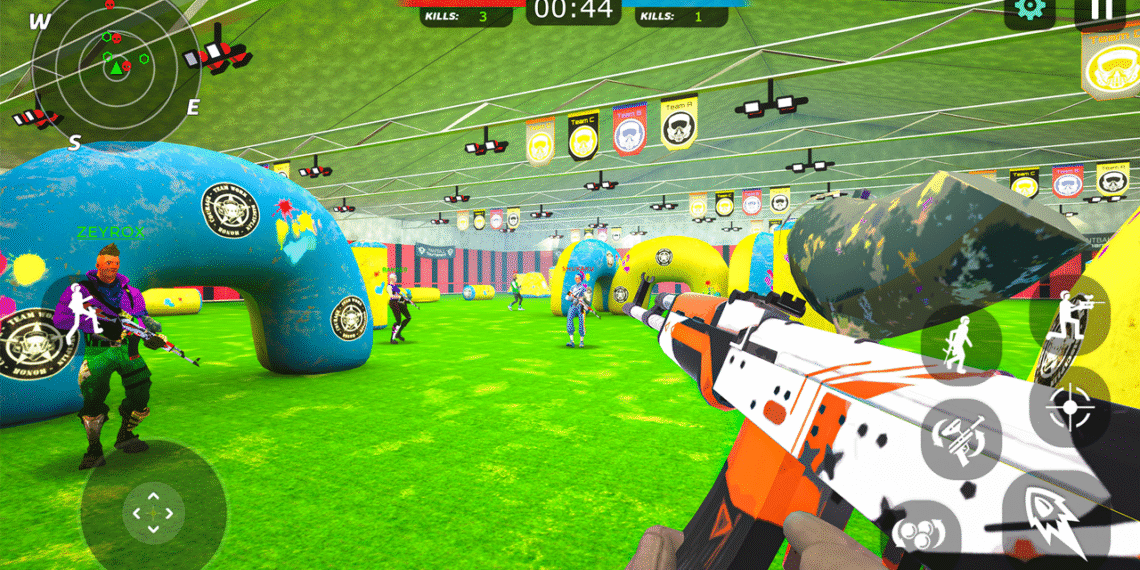Few activities can combine the thrill of combat, the camaraderie of teamwork, and the rush of pure adrenaline quite like paintball games. Whether it’s a weekend hobby, a corporate team-building event, or a full-scale tournament, paintball offers players a heart-pounding adventure that tests both body and mind.
The sport’s magic lies in its unpredictability — every match is different, every opponent is unique, and every hit leaves a colorful reminder of battle. But beyond the paint-splattered chaos lies a world rich in history, strategy, and community spirit.
This article dives deep into the story of paintball, its evolution, its diverse game modes, and what makes it one of the most immersive recreational sports in the world today.
The Birth of Paintball: From Forest Games to Global Phenomenon
An Unlikely Beginning
The origins of paintball might surprise you. It didn’t begin as a military simulation or competitive sport but rather as a simple idea among friends. In the early 1980s, a group of outdoor enthusiasts in New Hampshire, USA, decided to use paint-marking guns — originally designed for tagging trees and livestock — for a survival-themed game in the woods.
That first match was small, but it ignited a concept that quickly grew. The combination of hunting, hide-and-seek, and tactical combat created an entirely new form of entertainment. What started as a friendly dare evolved into an organized sport with defined rules, safety gear, and international tournaments.
The Rise of Organized Play
By the late 1980s, paintball had transformed from backyard skirmishes into a legitimate sport. Commercial fields opened across the United States, offering rental gear and designated arenas. Tournaments began appearing, drawing players from around the world.
As the sport matured, so did the technology. Early pump-action markers gave way to semi-automatic and electronic paintball guns. Protective gear became more sophisticated, ensuring safety without compromising freedom of movement.
Today, paintball is played globally — in dense forests, abandoned buildings, desert fields, and inflatable arenas. It has evolved into a thrilling mix of fitness, strategy, and fun.
Understanding Paintball Games: More Than Just Shooting Paint
To an outsider, paintball may seem like simple chaos — people running around shooting colored pellets. But players know better. Behind every match lies strategy, teamwork, and a deep understanding of tactics. This is where paintball games truly shine.

Game Formats and Objectives
Paintball isn’t a one-size-fits-all activity. It comes in many formats, each with its own set of rules, objectives, and level of intensity. Some of the most popular types include:
- Capture the Flag – The classic version. Two teams race to capture the opposing flag while protecting their own base. It emphasizes coordination, timing, and defense.
- Elimination – Simple and brutal. The last player or team standing wins. Perfect for those who thrive on survival and quick thinking.
- Attack and Defend – One team holds a position while the other tries to overtake it within a set time limit. Great for training defensive strategies.
- Scenario Games – Large-scale events that simulate real-life missions or historical battles, sometimes lasting for hours or even days.
- Speedball – A fast-paced, tournament-style game played on smaller, inflatable fields. It’s about reflexes, communication, and precision.
Each version tests different skills — whether it’s patience in the woods, agility on open fields, or teamwork under pressure.
Gear That Defines the Game
No paintball experience is complete without the right equipment. Players rely on a mix of safety and tactical gear:
- Paintball Marker (Gun): The main tool of the trade, available in mechanical, semi-automatic, and electronic models.
- Mask and Goggles: Essential for eye and face protection.
- Hopper: A container that feeds paintballs into the marker.
- CO₂ or Compressed Air Tank: Powers the gun to shoot paintballs at regulated speeds.
- Protective Clothing: From padded jerseys to tactical vests, gear minimizes the sting of paint impacts.
Together, these elements create a perfect balance of safety and intensity, allowing players to focus purely on the thrill of the game.
Strategy, Skill, and the Art of Teamwork
The Mindset of a Paintball Player
While speed and aim are important, victory in paintball often comes down to mental sharpness. Every player quickly learns that blind aggression rarely works. Strategy, patience, and anticipation are key.
Reading opponents, using cover wisely, and communicating effectively with teammates can turn the tide of any match. The best players think several moves ahead, much like chess masters in camouflage.
The Importance of Communication
Paintball is as much about communication as it is about shooting. Teams that talk — calling out positions, planning ambushes, or signaling retreat — have a massive advantage. Silent coordination can lead to victory even against faster, more experienced opponents.
Hand signals, radio headsets, or simple code words often become second nature to players. In this way, paintball games teach not just reflexes but real-world teamwork and leadership.
Fitness and Focus
It’s easy to underestimate the physical demands of paintball. Matches require running, diving, crouching, and reacting quickly under stress. Players develop agility, endurance, and spatial awareness.
Beyond the body, it’s a mental workout. Paintball tests decision-making under pressure, adaptability, and emotional control. Few sports demand this combination of intellect and intensity — and that’s what makes it so addictive.
The Paintball Community: Friendship in the Line of Fire
Building Bonds Through Battle
What truly separates paintball from other sports is its community. Players form strong bonds through shared experiences — victories, losses, laughter, and the occasional bruised ego.
Whether it’s a weekend group of friends or a competitive team, the sense of belonging is powerful. Many describe paintball not just as a hobby, but as a lifestyle that fosters discipline, respect, and camaraderie.
Competitive Spirit and Global Events
From local tournaments to world championships, paintball’s competitive side is thriving. Professional leagues have emerged with organized rules, sponsors, and international recognition.
Events like large-scale scenario battles often attract thousands of players. Some even dress in military uniforms or themed costumes, turning each event into a living story — where history, fantasy, and reality collide.
These competitions not only showcase elite skill but also highlight the passion that drives the sport forward.
Safety First: Playing Smart and Staying Protected
Rules That Keep the Game Fun
Safety is the cornerstone of paintball. Every reputable field enforces strict rules designed to protect players while maintaining excitement.
Key guidelines include:
- Always wearing masks during play.
- Keeping barrel covers on when off the field.
- Using regulated air pressure and velocity limits.
- Respecting referee decisions and fair play.
Paintball may look intense, but when played responsibly, it’s safer than many contact sports. The sport’s emphasis on respect ensures that players can compete fiercely while maintaining integrity and sportsmanship.
Why Paintball Games Capture the Human Spirit
More Than Just a Sport
Paintball isn’t only about hitting targets — it’s about living in the moment. The thrill of sneaking behind enemy lines, the rush of dodging incoming shots, the satisfaction of pulling off a perfect ambush — these moments create memories that last.
It appeals to something primal in us — the instinct to move, strategize, and overcome. Yet it also speaks to something noble: teamwork, creativity, and discipline.
For many, paintball games are an escape from routine — a place where stress melts away under the excitement of battle, and friendships are built through shared victories and colorful defeats.
The Evolution of Paintball: Technology and the Future
The Rise of Innovation
Modern paintball technology continues to push boundaries. Lightweight markers, advanced air systems, and smart masks have transformed how the game is played.
Even virtual elements are entering the mix — digital scoring, augmented reality modes, and wearable sensors that track hits and stats. These innovations make the sport more accessible and exciting for new generations.
Sustainability and the Next Generation
With growing awareness of environmental issues, paintball manufacturers now produce eco-friendly paintballs made from biodegradable materials. Fields are becoming greener, focusing on sustainable operations without compromising the fun.
As more young players join, the future of paintball looks bright — inclusive, innovative, and deeply connected to community spirit.
Conclusion
In the end, paintball games represent more than just competition. They embody excitement, strategy, and the human need for challenge and connection.
From the first pulse of adrenaline as you take cover to the satisfaction of a well-earned victory, every moment tells a story — of courage, teamwork, and joy.
Paintball is not just about splattering colors; it’s about painting memories. And whether you play for fun, fitness, or glory, one truth remains: once you experience the rush of the game, you’ll never see a blank field the same way again.
Also read :The Legendary Flight: Exploring the World of x trench run















